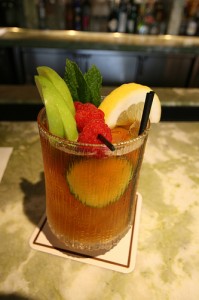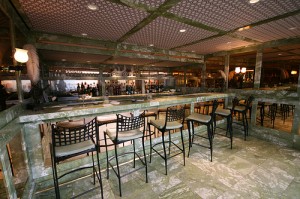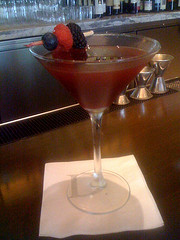Croquet and bowling share one essential attribute: An inverse ratio between the quality of one’s play and the quantity of liquor one imbibes. The more you drink, the less anyone cares how badly you play.
It was last year at the inaugural meeting of the Royal Croquet Society of Los Angeles, an august group devoted to the pursuit of afternoon boozing, that I discovered the Pimm’s Cup.
Sweet, fizzy, with an earthy undertone rebuffing any inclination toward the cloying, this golden-brown drink is traditionally mixed in large batches and garnished with slivers of lemon and cucumber. It’s the perfect cocktail for a summer afternoon of placid decadence. Drinking it is like living in an Evelyn Waugh novel but without the Catholic guilt.
Dating back to the early 19th century, the Pimm’s Cup is the official drink of Wimbledon (so much classier than Gatorade) and a summer staple in Britain. Its transition across the Atlantic, however, has fared less well.
“In all my years of managing bar, I never made a Pimm’s Cup,” says Michael Shearin, beverage director and sommelier of Drago Centro in downtown L.A. “But I always had a bottle of the stuff, sitting in the back of the bar, gathering dust.”
Like the mousy girl no one noticed in high school who shows up at the class reunion looking disarmingly hot, that Pimm’s bottle has been dusted off.
“I’ve noticed people drinking [Pimm’s] more. There does seem to be a resurgence,” says Shearin, who recently passed a grueling, five-day Master Sommelier exam.
For a cocktail with such a storied history, it’s not “well served” on our side of the pond.
Recipe for Disaster
The problem with the Pimm’s Cup begins on the bottle:
Fill a tall glass halfway with ice. Add 1.5oz of Pimm’s. Top off with ginger ale or lemon-lime soda. Garnish with a slice of lemon.
Pimm’s is Pimm’s No. 1 Cup, a liqueur made from a recipe so secret only six people in the world are said to know it. As best as anyone can guess, it’s gin, sweet vermouth, fruit juices and herbs. Whatever those botanicals are, they give Pimm’s its low, earthy notes.
As for “top off,” there are no specifications on just how much soda to add. Mr. Boston recommends a 2:3 ratio of liqueur to “ginger ale or lemon-lime soda,” while most recipes call for a 1:2 ratio.
Pimm’s was invented by oyster bar owner James Pimm in London, at a time when English lemonade and lemon-lime soda were very different libations than modern American lemonade or 7-Up. What we drink now is much sweeter and less astringent. Squirting a dose of 7-Up into a splash of Pimm’s is like pouring sweet on top of sweet. Even a ginger ale like Schweppes, a vast improvement over 7-Up, is far too sweet and can overwhelm the drink.
At most bars, even British-themed pubs that ought to know better, the sassy, slightly sour cocktail I fell in love with on the croquet lawn becomes a bland, syrupy mess. At Ye Olde King’s Head pub in Santa Monica, the Pimm’s Cup is an abomination — served with a maraschino cherry. When I called The Cat & Fiddle in Hollywood to ask about their Pimm’s Cup, I was told, “We do it with our own special twist.” Watching the bartender make it, apparently that “special twist” meant half soda water and half 7-Up. Two buttons on the soda gun instead of one. Quite a twist.
Quest Ends in Palm Springs
In Palm Springs at the Parker Hotel on a lazy Monday afternoon following the Fourth of July, the bartender apologetically explained he’d have to make my Pimm’s Cup with ginger ale. The drink had proved so popular the previous weekend, he’d run out of ginger beer. A minor glitch, to be sure, but he did the drink proud. He squeezed in fresh lemon juice, which offset the ginger ale, and garnished the drink with slices of apple, lemon and cucumber, a skewer of raspberries and a sprig of mint. It was the best Pimm’s Cup I tried.
The traditions of the Pimm’s Cup — mixed in large batches, poured from pitchers and served in tall glasses — are constantly being challenged, mostly for the worse here in the U.S. At Drago Centro, however, where the cocktail menu changes seasonally, Shearin and head bartender Jaymee Mandeville have created When In London ($12), a drink that reinvents the Pimm’s Cup with a berry-themed twist.
It’s part of a much larger revival of classic cocktails and, more specifically, the resurgence of gin. For Shearin, who once worked as a bellman in Las Vegas and was introduced to Pimm’s when he got a bottle of it from a departing guest, his goal is more personal: To introduce his patrons to all those forlorn, unloved bottles behind the bar. (He recently added the Harvey Wallbanger to Drago Centro’s Happy Hour menu as a way to incorporate the Italian liqueur Galliano.)
When making a When In London, Shearin starts by muddling two raspberries, three blueberries, two blackberries and two cucumber slices with a 1/2-ounce of lemon juice. He strains the pulpy mass to remove the seeds, adds a 1/2-ounce of simple syrup (more if the berries are tart), 1 ounce of Pimm’s and fortifies it with 1 ounce of Bombay Sapphire gin. “Americans like to get their money’s worth,” he says. He shakes and re-strains the concoction then serves it in a martini glass garnished with three berries on a sugarcane skewer.
Is it delicious? Yes. A bit elaborate for the home bartender? Probably.
After all my searching, I have found the best Pimm’s Cup is the one I make at home.
2 oz. Pimm’s for every 4 oz. Reed’s Ginger Beer. A splash of gin. A dash of freshly squeezed lemon juice (enough to intensify the Pimm’s). Garnish with thinly sliced lemon and cucumber rounds and, if handy, mint.
I like to mix up pitchers of the stuff and keep them handy to serve on summer afternoons. As Pimm’s is only 50-proof, you can drink cocktail after cocktail while making wicket after wicket. I may never sip one of these with the British gentry in a croquet club or with royalty in a courtside box at Wimbledon, but it remains the archetypal libation of my Anglophiliac fantasy life.



Yes, the Pimm’s Cup is a great summertime drink. It’s refreshing without being cloyingly sweet and it should definitely be made by the pitcher!